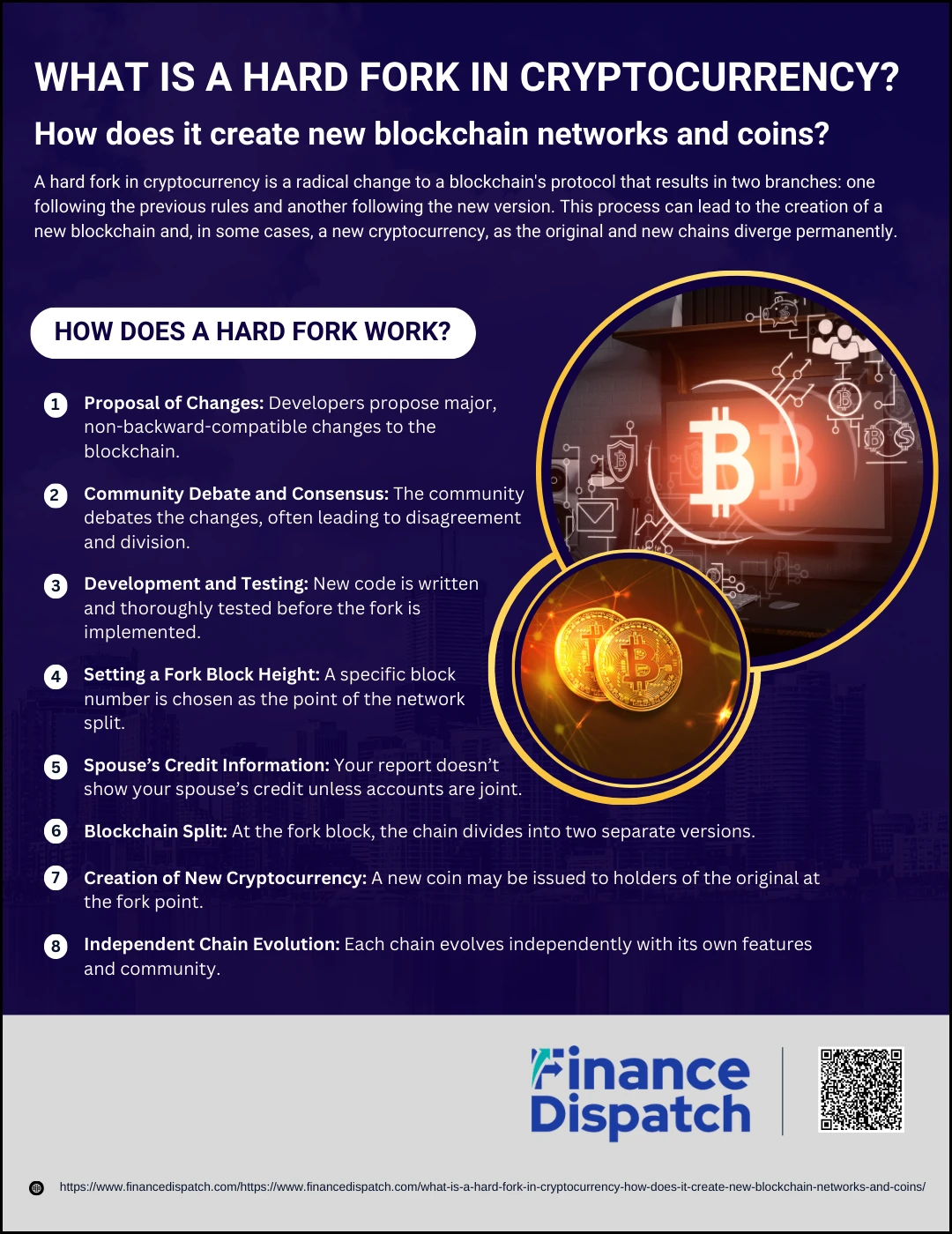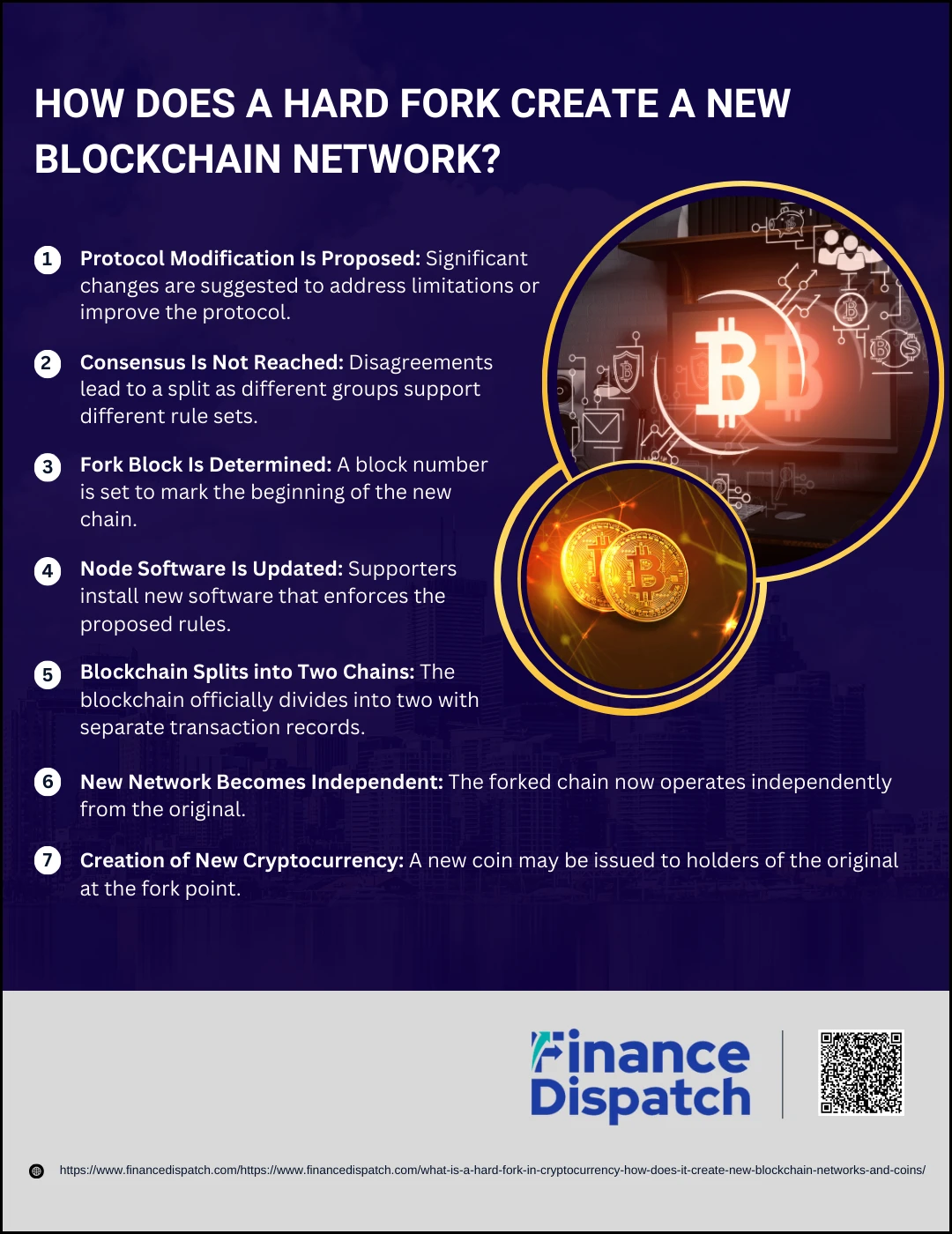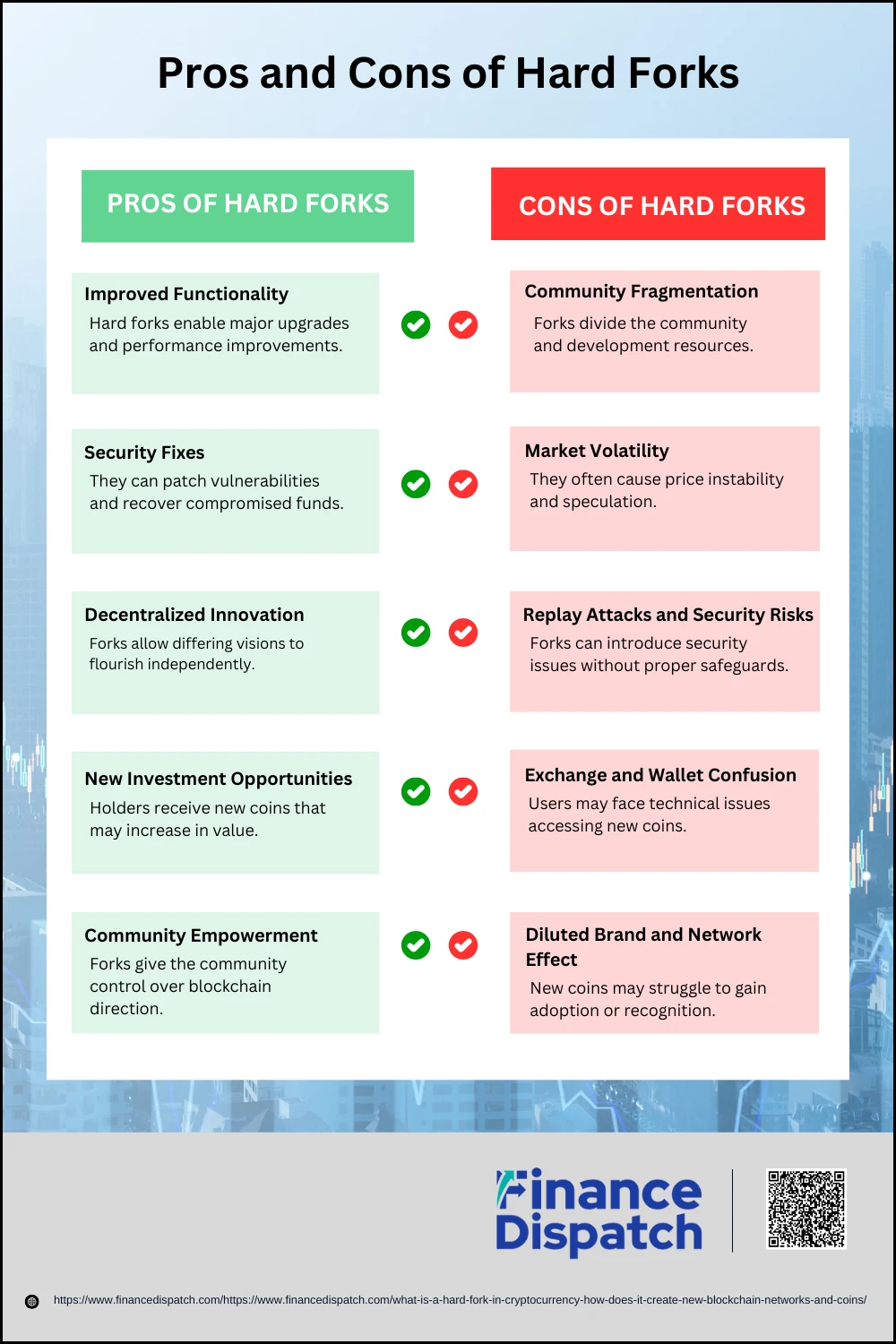In the fast-evolving world of cryptocurrency, change is not only inevitable—it’s essential. One of the most dramatic ways this change occurs is through what’s known as a hard fork. If you’ve ever seen two cryptocurrencies with similar names—like Bitcoin and Bitcoin Cash or Ethereum and Ethereum Classic—you’ve likely encountered the result of a hard fork. But what exactly does this mean? In simple terms, a hard fork is a significant upgrade to a blockchain’s underlying rules that causes the network to split, leading to the creation of an entirely new blockchain—and often, a new cryptocurrency. This article breaks down what a hard fork is, why it happens, and how it results in the birth of new digital coins and networks that can shift the entire landscape of the crypto market.
What is a Hard Fork in Cryptocurrency?
A hard fork in cryptocurrency refers to a radical and permanent change to a blockchain’s underlying protocol that makes the new version incompatible with the previous one. When this happens, the blockchain splits into two separate networks—one following the old rules and the other adopting the new ones. This divergence creates two distinct blockchains, each maintaining its own path and, often, its own cryptocurrency. Unlike a soft fork, which is a backward-compatible upgrade, a hard fork results in a clear split where nodes and users must choose which version to support. This process is often driven by disagreements in the community, the need for enhanced features, or urgent security fixes, making hard forks a key force in the evolution and innovation of blockchain technology.
Key Characteristics of a Hard Fork
A hard fork is more than just a technical update—it’s a defining moment in the life of a cryptocurrency. It marks a decisive shift in a blockchain’s rules that results in the creation of a new, independent version of the network. Whether driven by community disagreements, security concerns, or ambitions for new features, hard forks come with distinct traits that set them apart from regular upgrades or soft forks.
Here are the key characteristics of a hard fork:
1. Permanent Split: The blockchain divides into two separate and incompatible chains, each with its own transaction history from the moment of the split onward.
2. New Cryptocurrency: A new digital coin is typically created and distributed to holders of the original cryptocurrency at the time of the fork.
3. Incompatibility: The new blockchain protocol is not backward-compatible, meaning nodes must upgrade to continue participating in the new chain.
4. Community Division: Hard forks often result from differing visions within the community, leading to a split among developers, miners, and users.
5. Token Duplication: Users who held coins on the original blockchain before the fork usually receive an equal number of coins on the new blockchain.
6. Independent Development: Both chains continue to develop independently, with separate roadmaps, governance, and technical upgrades.
7. Potential Market Volatility: The creation of a new coin can introduce speculation, uncertainty, and fluctuations in value across both blockchains.
 How Does a Hard Fork Work?
How Does a Hard Fork Work?
A hard fork is a process that causes a blockchain to split into two distinct versions, each with its own rules, development path, and cryptocurrency (if applicable). While it may seem sudden, a hard fork usually follows a structured sequence of events, involving community input, development work, and technical execution. Let’s break down each step in more detail:
1. Proposal of Changes
The process usually begins when developers or stakeholders identify a critical issue or potential improvement within the blockchain. This could relate to scalability problems, outdated features, network congestion, or security vulnerabilities. They formally propose a change to the protocol that cannot be implemented with a backward-compatible upgrade (i.e., a soft fork).
2. Community Debate and Consensus
Once the proposal is made public, it often triggers intense discussion within the community—developers, miners, validators, and users alike. Not everyone may agree with the proposed direction. If a significant portion of the community supports the new proposal but others oppose it, a split in ideology may occur. This division is often the root cause of a hard fork.
3. Development and Testing
Developers backing the new direction begin writing and testing code for the proposed changes. Rigorous testing in controlled environments or testnets is carried out to detect bugs and ensure the new software behaves as expected. This phase is crucial to avoid vulnerabilities once the fork goes live.
4. Setting a Fork Block Height
A specific block number—called the fork block height—is chosen as the exact point where the network will diverge. This gives node operators, miners, and exchanges time to prepare and update their systems if they choose to support the new version.
5. Network Upgrade
As the chosen block height approaches, nodes and miners that support the new version upgrade their software to follow the new rules. This step is essential because only nodes running the upgraded software will be able to interact with the new chain after the fork.
6. Blockchain Split
At the specified block, the protocol change takes effect. The blockchain splits into two versions:
- One continues operating under the original rules.
- The other begins functioning with the new protocol.
Both blockchains share the same history up until the fork point but become completely separate afterward.
7. Creation of New Cryptocurrency
A new cryptocurrency is often born from the fork. Everyone who held the original coin at the fork block receives an equivalent number of new coins on the new chain (assuming the fork includes a coin split). This gives users ownership in both blockchains, even though their values and paths may differ.
8. Independent Chain Evolution
After the fork, the two blockchains operate independently. Each chain may follow different development roadmaps, upgrade cycles, and community decisions. Their prices, security models, and adoption levels evolve separately, potentially leading one to thrive and the other to fade—or both to coexist with different use cases.
 How Does a Hard Fork Create a New Blockchain Network?
How Does a Hard Fork Create a New Blockchain Network?
A hard fork is more than just a protocol upgrade—it is a structural transformation that leads to the birth of a new blockchain. This happens when a group within the blockchain’s community disagrees with the current direction and introduces a new set of rules that aren’t compatible with the existing network. As a result, the blockchain splits, and two distinct chains—and often two different communities—emerge. Here’s a closer look at how this process unfolds:
1. Protocol Modification Is proposed
A group of developers, miners, or stakeholders identifies limitations, risks, or new opportunities within the existing blockchain. They propose a set of fundamental changes to the protocol—like changing the consensus mechanism, increasing block size, or reversing past transactions—that can’t be implemented through a soft fork. These changes aim to enhance functionality, address community demands, or fix serious vulnerabilities.
2. Consensus Is Not Reached
In a decentralized system, any significant update requires community support. However, the larger the change, the more likely it is to cause disagreement. When consensus cannot be reached and different groups favor different directions, those in support of the new rules move toward initiating a hard fork, while others stay with the current version. This divergence sets the stage for two separate chains to emerge.
3. Fork Block Is determined
A specific block height (e.g., Block #500,000) is selected as the fork point. This is the block at which the new rules will be enforced. Until that moment, both chains share the exact same transaction history. After this point, they begin recording their own unique transactions.
4. Node Software Is Updated
Supporters of the new chain—including developers, miners, and full node operators—install and run the updated version of the blockchain software that incorporates the new rules. These updated nodes no longer recognize the original chain’s blocks as valid after the fork block, and vice versa. This incompatibility between the two versions solidifies the split.
5. Blockchain Splits into Two Chains
Once the fork block is mined, the chain officially splits into two separate blockchains. One chain follows the original protocol, while the other continues on the new set of rules. Although they share a common history, from the fork point onward, each blockchain records its own independent set of blocks and transactions.
6. New Network Becomes Independent
The newly forked blockchain now operates as its own network with distinct consensus mechanisms, governance, features, and security models. It has the technical capacity to build on its own roadmap and evolve independently, no longer tethered to the decisions of the original chain’s developers.
7. New Ecosystem and Community Forms
Over time, a new ecosystem begins to form around the forked chain. Developers launch dApps, tools, and upgrades tailored to the new network. Exchanges may list the new cryptocurrency, wallets start supporting it, and a new community—comprising users, miners, and advocates—rallies around it. While some forked chains fade into obscurity, others—like Bitcoin Cash or Ethereum Classic—establish lasting influence and develop independently for years.
What Happens to the Original and New Coins?
When a hard fork takes place, the blockchain splits into two separate networks—each operating under different rules. As a result, the cryptocurrency associated with the blockchain also splits. Users who held coins on the original blockchain before the fork typically receive an equal number of coins on the new chain. However, these coins, although cloned from the same origin, become two entirely different digital assets that are not interchangeable. Each coin now operates independently, with its own supply, demand, value, and ecosystem.
Here’s a comparison of what happens to the original and new coins after a hard fork:
| Aspect | Original Coin | New Coin (Forked Version) |
| Blockchain History | Maintains full history up to and beyond fork | Shares history up to fork, diverges afterward |
| Coin Ownership | Users keep original holdings | Users receive equal number of new coins |
| Compatibility | Continues under old protocol | Requires updated wallet/software |
| Market Value | Generally more stable and widely accepted | Value determined by new adoption and demand |
| Community Support | Backed by majority/miners of the original chain | Supported by those favoring the new direction |
| Development Path | Follows original roadmap | Adopts new features, vision, or governance |
| Symbol/Ticker | Retains original name (e.g., BTC) | Gets a new name (e.g., BCH, ETC, BSV) |
| Exchange Listing | Already listed and widely traded | May require re-listing and exchange support |
Famous Examples of Hard Forks
Hard forks have played a major role in the evolution of the cryptocurrency landscape. Some have led to successful new blockchains and coins with dedicated communities, while others have faded due to low adoption or technical challenges. These forks often reflect deep disagreements or innovations within crypto communities, and they highlight how flexible and open-source blockchain technology really is. Below are some of the most well-known and influential hard forks in crypto history:
1. Bitcoin → Bitcoin Cash (BCH)
Date: August 1, 2017
Reason: To address Bitcoin’s scalability issues by increasing block size from 1 MB to 8 MB, enabling faster and cheaper transactions.
2. Bitcoin Cash → Bitcoin SV (BSV)
Date: November 15, 2018
Reason: Disagreement within the Bitcoin Cash community over technical upgrades and block size. BSV (Satoshi Vision) was created with a larger block size focus.
3. Bitcoin → Bitcoin Gold (BTG)
Date: October 24, 2017
Reason: To decentralize mining by using the Equihash algorithm, allowing regular users with GPUs to mine instead of relying on ASICs.
4. Ethereum → Ethereum Classic (ETC)
Date: July 20, 2016
Reason: After the DAO hack, Ethereum developers reversed the hack through a hard fork. The original chain, supported by those valuing immutability, became Ethereum Classic.
5. Ethereum → Ethereum 2.0 (Eth2)
Date: Phased upgrade since 2020
Reason: To transition from Proof of Work (PoW) to Proof of Stake (PoS), improving scalability, energy efficiency, and network performance.
6. Zcash → Ycash (YEC)
Date: July 18, 2019
Reason: Aimed to preserve mining on home hardware and eliminate the Founders’ Reward, giving more power to the community.
7. Dash (formerly Darkcoin) Hard Fork
Date: March 2015
Reason: Rebranded and forked to enhance governance and privacy features, leading to the creation of the Dash DAO structure.
 Pros and Cons of Hard Forks
Pros and Cons of Hard Forks
Hard forks are one of the most powerful mechanisms in blockchain development, offering both potential breakthroughs and significant risks. They can spark innovation, strengthen networks, and create new digital assets—but they can also lead to confusion, division, and vulnerability. Below are the key pros and cons, fully explained:
Pros
1. Improved Functionality
A hard fork can implement much-needed upgrades that aren’t possible through minor updates. This may include increasing block size for faster transactions, reducing fees, or enhancing smart contract capabilities. These upgrades can make the blockchain more efficient and appealing to users and developers.
2. Security Fixes
Some hard forks are created specifically to address vulnerabilities or recover lost funds. For example, after the DAO hack in 2016, Ethereum executed a hard fork to restore stolen Ether. Such forks can help repair damage from attacks and prevent future breaches, increasing user trust in the network.
3. Decentralized Innovation
In open-source blockchain communities, not everyone will agree on the future of a project. A hard fork allows dissenting voices to implement their vision without being blocked by the majority. This freedom to experiment can lead to diverse and competitive ecosystems, benefiting the wider crypto space.
4. New Investment Opportunities
Users who hold the original coin before a hard fork typically receive an equal number of the new coin. If the new coin gains traction, its value can increase over time, providing a return on investment. For example, holders of Bitcoin received Bitcoin Cash after the 2017 fork, essentially doubling their assets.
5. Community Empowerment
Hard forks embody the decentralized philosophy of blockchain. Instead of relying on centralized leadership, communities can vote with their code—forking the network to express their vision. This empowers users to shape the future of a blockchain directly.
Cons
1. Community Fragmentation
Hard forks often result from disagreements, and the aftermath can split the community. Developers, miners, and users may divide their efforts between two competing chains, weakening both. This fragmentation can dilute innovation, resources, and brand identity.
2. Market Volatility
The launch of a new coin often leads to price speculation and trading frenzies. This can cause sharp spikes or drops in the value of both the original and forked cryptocurrencies. The uncertainty surrounding the fork’s success adds to short-term instability in the market.
3. Replay Attacks and Security Risks
In some cases, transactions made on one chain can be maliciously repeated on the other chain—known as a replay attack. Unless proper replay protection is built into the fork, both chains are vulnerable. Additionally, splitting miners between two networks can reduce hash power, weakening the security of both blockchains.
4. Exchange and Wallet Confusion
After a fork, not all wallets or exchanges immediately support the new coin. Users may struggle to access their newly issued tokens or send them safely. In worst-case scenarios, funds may be lost due to user errors or lack of technical guidance.
5. Diluted Brand and Network Effect
Forked coins often struggle to achieve the same level of adoption as the original. Without a strong community, developer support, or market demand, the new coin may fade into irrelevance. Additionally, the split can confuse users about which coin represents the “true” version of the blockchain.
Hard Fork vs. Soft Fork: Quick Comparison
In the world of blockchain, both hard forks and soft forks are used to update or improve a cryptocurrency’s protocol. While they may sound similar, they have fundamentally different outcomes and impacts on the blockchain and its community. A hard fork creates a permanent split in the blockchain, resulting in two separate networks and possibly two different cryptocurrencies. A soft fork, on the other hand, is a backward-compatible change that allows all users—regardless of whether they’ve updated their software—to still interact within a single unified network. Understanding the difference is crucial for anyone involved in cryptocurrency.
Here’s a quick comparison of hard forks and soft forks:
| Aspect | Hard Fork | Soft Fork |
| Compatibility | Not backward-compatible | Backward-compatible |
| Blockchain Outcome | Results in two separate blockchains | Maintains a single blockchain |
| New Cryptocurrency | Often creates a new coin | No new coin is created |
| Community Impact | May split the community into different factions | Generally maintains community unity |
| Update Requirement | Requires all nodes to upgrade to remain on the new chain | Only upgraded nodes enforce the new rules |
| Use Cases | Major upgrades, disagreements, or security fixes | Minor improvements or feature restrictions |
| Risk of Replay Attacks | Higher if not properly protected | Low to none |
| Example | Bitcoin → Bitcoin Cash, Ethereum → Ethereum Classic | Bitcoin SegWit, Ethereum Constantinople upgrade |
Why Do Developers and Communities Choose to Hard Fork?
Developers and communities often choose to hard fork when they believe the existing blockchain protocol no longer aligns with their vision, technical needs, or security requirements. A hard fork provides a way to implement major changes that aren’t possible through backward-compatible upgrades. These changes can include increasing transaction speeds, enhancing scalability, reversing malicious transactions after a hack, or shifting to a new consensus mechanism like Proof of Stake. Sometimes, ideological disagreements—such as whether a blockchain should prioritize decentralization or efficiency—can also lead to a hard fork. By creating a separate chain, developers can pursue innovation without waiting for unanimous approval, while communities can support the version of the blockchain that best matches their values and goals.
Conclusion
Hard forks are powerful moments in a blockchain’s evolution—representing both technical change and community choice. Whether driven by innovation, security needs, or philosophical differences, a hard fork allows developers and users to take control of a blockchain’s direction. While they can result in stronger, more adaptable networks and even generate new cryptocurrencies, they also come with risks like fragmentation, confusion, and volatility. Understanding how hard forks work, why they happen, and what they mean for users is essential for anyone involved in the cryptocurrency space. As blockchain technology continues to mature, hard forks will remain a key force shaping its future.



